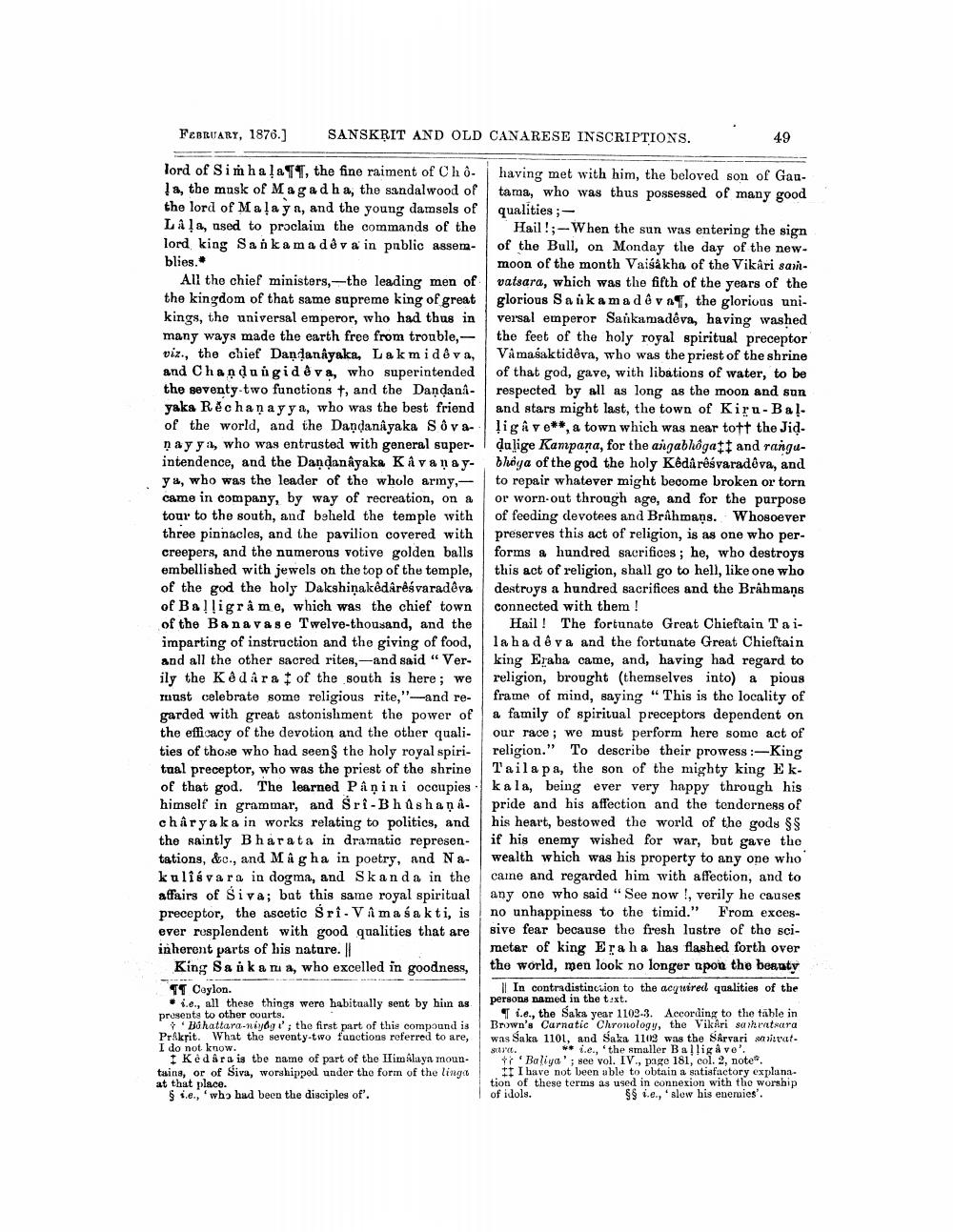________________
FEBRUARY, 1876.]
SANSKRIT AND OLD CANARESE INSCRIPTIONS.
49
lord of Sinhala TT, the fine raiment of Chô. | having met with him, the beloved son of Gau1 a, the musk of Magadha, the sandalwood of tama, who was thus possessed of many good the lord of Malaya, and the young damsels of qualities; Lila, nsed to proclaim the commands of the Hail!;-When the sun was entering the sign lord king San ka ma deva in public assem- of the Bull, on Monday the day of the newblies.
moon of the month Vaisakha of the Vikari sanAll the chief ministers,--the leading men of vatsara, which was the fifth of the years of the the kingdom of that same supreme king of great glorious Saúkama dê var, the glorious unikings, the universal emperor, who had thus in versal emperor Sankamadêva, having washed many ways made the earth free from trouble, - | the feet of the holy royal spiritual preceptor viz., the chief Dandanayaka, Lakmid & va, Vámasaktideva, who was the priest of the shrine and Chandungid êva, who superintended of that god, gave, with libations of water, to be the seventy-two functions t, and the Dandani- respected by all as long as the moon and sun yaka Rechaņay ya, who was the best friend and stars might last, the town of Kiru-Bal. of the world, and the Dandanayaka Sôva- liga ve**, a town which was near tott the Jid. ņay y, who was entrusted with general super- dalige Kampana, for the angabhôgait and ranguintendence, and the Dandanayaka Kåvan ay- bhôya of the god the holy Kêdî rêśvaradova, and ys, who was the leader of the whole army, to repair whatever might become broken or torn came in company, by way of recreation, on a or worn-out through age, and for the purpose tour to the south, and beheld the temple with of feeding devotees and Brihmang. Whosoever three pinnacles, and the pavilion covered with preserves this act of religion, is as one who percreepers, and the numerous votive golden balls forms a hundred sacrifices; he, who destroys embellished with jewels on the top of the temple, this act of religion, shall go to hell, like one who of the god the holy Dakshiņakêdêrêsvaradevadestroys a hundred sacrifices and the Brahmaņs of Balligrame, which was the chief town connected with them! of the Banavase Twelve-thousand, and the Hail! The fortunate Great Chieftain Taiimparting of instruction and the giving of food, laha dê va and the fortunate Great Chieftain and all the other sacred rites,--and said "Ver- king Eraba came, and, having had regard to
y the Kedara f of the south is here; we religion, brought (themselves into) a pious mast celebrate some religious rite,"--and re- frame of mind, saying “This is the locality of garded with great astonishment the power of a family of spiritual preceptors dependent on the efficacy of the devotion and the other quali. our race; we must perform here some act of ties of those who had seen the holy royal spiri- religion." To describe their prowess :-King taal preceptor, who was the priest of the shrine Taila pa, the son of the mighty king Ek. of that god. The learned Pâņini occupies kala, being ever very happy through his himself in grammar, and Sri Bhushana- pride and his affection and the tenderness of charyaka in works relating to politics, and his heart, bestowed the world of the gods $$ the saintly Bharata in dramatic represen- if his enemy wished for war, but gave the tations, &c., and Mag ha in poetry, and Na- wealth which was his property to any one who kuliśvara in dogma, and Skanda in the came and regarded him with affection, and to affairs of Siva; bat this same royal spiritual | any one who said " See now !, verily he causes preceptor, the ascetic Sri. Vi masakti, is no unhappiness to the timid." From excesever rusplendent with good qualities that are sive fear because the fresh lustre of the sciinherent parts of his nature. |
metar of king Eraha has flashed forth over King Sa i ka nu a, who excelled in goodness, the world, men look no longer upon the beauty TT Caylon.
|| In contradistinction to the acquired qualities of the • i.e., all these things were habitually sent by him as
persons named in the text. presents to other courts.
T i.e., the Saka year 1102-3. According to the table in Buhattara-niyogi'; the first part of this compound is Brown's Carnatic Chronology, the Vikari sahratara Prakrit. What the seventy-two functions referred to are, was Saka 1101, and Saka 1102 was the Sårvari saviratI do not know.
str. ** i.e., 'the smaller Ballig å ve'. I Kėdara is the name of part of the Himalaya moun.
Baliya'; see vol. IV., page 181, col. 2, note tains, or of Siva, worshipped under the form of the lingi 11 I have not been able to obtain a satisfactory explana. at that place.
tion of these terms as used in connexion with the worship $se, who had been the disciples of'.
of idols.
SS i.e., 'slew his enemies'.




